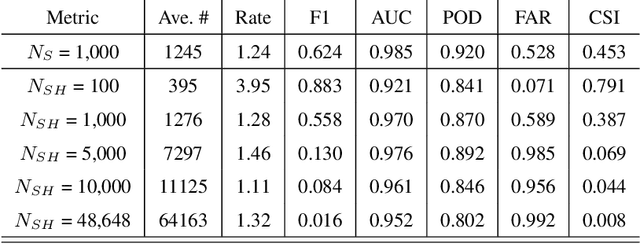Gabrielle Gantos
Evidential Deep Learning: Enhancing Predictive Uncertainty Estimation for Earth System Science Applications
Sep 22, 2023Abstract:Robust quantification of predictive uncertainty is critical for understanding factors that drive weather and climate outcomes. Ensembles provide predictive uncertainty estimates and can be decomposed physically, but both physics and machine learning ensembles are computationally expensive. Parametric deep learning can estimate uncertainty with one model by predicting the parameters of a probability distribution but do not account for epistemic uncertainty.. Evidential deep learning, a technique that extends parametric deep learning to higher-order distributions, can account for both aleatoric and epistemic uncertainty with one model. This study compares the uncertainty derived from evidential neural networks to those obtained from ensembles. Through applications of classification of winter precipitation type and regression of surface layer fluxes, we show evidential deep learning models attaining predictive accuracy rivaling standard methods, while robustly quantifying both sources of uncertainty. We evaluate the uncertainty in terms of how well the predictions are calibrated and how well the uncertainty correlates with prediction error. Analyses of uncertainty in the context of the inputs reveal sensitivities to underlying meteorological processes, facilitating interpretation of the models. The conceptual simplicity, interpretability, and computational efficiency of evidential neural networks make them highly extensible, offering a promising approach for reliable and practical uncertainty quantification in Earth system science modeling. In order to encourage broader adoption of evidential deep learning in Earth System Science, we have developed a new Python package, MILES-GUESS (https://github.com/ai2es/miles-guess), that enables users to train and evaluate both evidential and ensemble deep learning.
Mimicking non-ideal instrument behavior for hologram processing using neural style translation
Jan 07, 2023Abstract:Holographic cloud probes provide unprecedented information on cloud particle density, size and position. Each laser shot captures particles within a large volume, where images can be computationally refocused to determine particle size and shape. However, processing these holograms, either with standard methods or with machine learning (ML) models, requires considerable computational resources, time and occasional human intervention. ML models are trained on simulated holograms obtained from the physical model of the probe since real holograms have no absolute truth labels. Using another processing method to produce labels would be subject to errors that the ML model would subsequently inherit. Models perform well on real holograms only when image corruption is performed on the simulated images during training, thereby mimicking non-ideal conditions in the actual probe (Schreck et. al, 2022). Optimizing image corruption requires a cumbersome manual labeling effort. Here we demonstrate the application of the neural style translation approach (Gatys et. al, 2016) to the simulated holograms. With a pre-trained convolutional neural network (VGG-19), the simulated holograms are ``stylized'' to resemble the real ones obtained from the probe, while at the same time preserving the simulated image ``content'' (e.g. the particle locations and sizes). Two image similarity metrics concur that the stylized images are more like real holograms than the synthetic ones. With an ML model trained to predict particle locations and shapes on the stylized data sets, we observed comparable performance on both simulated and real holograms, obviating the need to perform manual labeling. The described approach is not specific to hologram images and could be applied in other domains for capturing noise and imperfections in observational instruments to make simulated data more like real world observations.
Neural network processing of holographic images
Mar 18, 2022



Abstract:HOLODEC, an airborne cloud particle imager, captures holographic images of a fixed volume of cloud to characterize the types and sizes of cloud particles, such as water droplets and ice crystals. Cloud particle properties include position, diameter, and shape. We present a hologram processing algorithm, HolodecML, that utilizes a neural segmentation model, GPUs, and computational parallelization. HolodecML is trained using synthetically generated holograms based on a model of the instrument, and predicts masks around particles found within reconstructed images. From these masks, the position and size of the detected particles can be characterized in three dimensions. In order to successfully process real holograms, we find we must apply a series of image corrupting transformations and noise to the synthetic images used in training. In this evaluation, HolodecML had comparable position and size estimation performance to the standard processing method, but improved particle detection by nearly 20\% on several thousand manually labeled HOLODEC images. However, the improvement only occurred when image corruption was performed on the simulated images during training, thereby mimicking non-ideal conditions in the actual probe. The trained model also learned to differentiate artifacts and other impurities in the HOLODEC images from the particles, even though no such objects were present in the training data set, while the standard processing method struggled to separate particles from artifacts. The novelty of the training approach, which leveraged noise as a means for parameterizing non-ideal aspects of the HOLODEC detector, could be applied in other domains where the theoretical model is incapable of fully describing the real-world operation of the instrument and accurate truth data required for supervised learning cannot be obtained from real-world observations.
 Add to Chrome
Add to Chrome Add to Firefox
Add to Firefox Add to Edge
Add to Edge